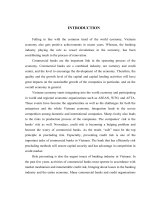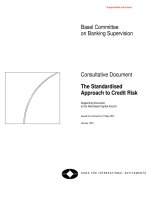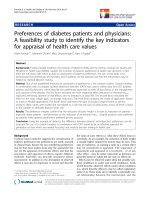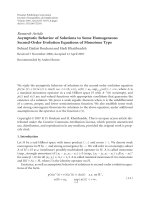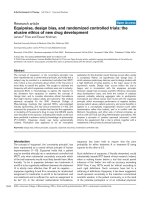Precluding and reducing solutions to credit risk at Quang Trung branch of Vietnam Bank of Investment and Development.doc
Bạn đang xem bản rút gọn của tài liệu. Xem và tải ngay bản đầy đủ của tài liệu tại đây (226.59 KB, 47 trang )
INTRODUCTION
Falling in line with the common trend of the world economy, Vietnam economy
also gets positive achievements in recent years. Whereas, the banking industry
playing the role as vessel circulations in the economy, has been contributing much in
the process of renovation.
Commercial banks are the important link in the operating process of the
economy. Commercial banks are a combined industry, are currency and credit center,
and the level to encourage the development of the economy. Therefore, the quality
and the growth level of the capital and capital lending activities will have great
impacts on the sustainable growth of the companies in particular, and on the overall
economy in general.
Vietnam economy starts integrating into the world economy and participating in
world and regional economic organizations such as ASEAN, WTO, and AFTA.
These events have become the opportunities as well as the challenges for both the
enterprises and the whole Vietnam economy. Integration leads to the severe
competition among domestic and international companies. Sharp rivalry also leads to
the risks in production process of the companies. The companies’ risk is the banks’
risk as well. Nowadays, credit risk is becoming a bulging problem and become the
worry of commercial banks. As the result, “safe” must be the top principle in
precluding risk. Especially, preventing credit risk is one of the important tasks of
commercial banks in Vietnam. The bank that has efficiently risk precluding methods
will ensure capital security and has advantage in competition in credit market.
Risk preventing is also the urgent issues of banking industry in Vietnam. In the
past few years, activities of commercial banks must operate in accordance with
market mechanism and innumerable credit risk, bringing about losses to the banking
industry and the entire economy. Many commercial banks and credit organizations
has very huge unprofitable debt ratio, even some banks must be bankrupt unless there
is interference from the government.
Concerning about risks, particularly credit risk in banking industry and Quang
Trung branch of Vietnam Bank of Investment and Development during my
internship, so I choose the below topic:
“Precluding and reducing solutions to credit risk at Quang Trung branch of
Vietnam Bank of Investment and Development”
Beside the introduction and conclusion part, the special subject is presented in
three main chapters:
Chapter 1: Overview of risk, significance of precluding and reducing risk in
credit relationships
Chapter 2: Methods of precluding and reducing credit risk in Quang Trung
branch of Vietnam Bank of Investment and Development
Chapter 3: Solutions to precluding and reducing credit risks at Quang Trung
branch, BIDV
Although having many efforts in studying and researching through books and
newspapers as well as gathering documents and figures during my internship at the
bank, but limited time and narrow awareness cause unavoidable shortcomings. I am
looking forward recommendation from the officers of the bank and the lecturers so I
can have a thorough grasp of knowledge serving my future job.
Chapter 1: Overview of risk, significance of precluding and
reducing risk in credit relationships
1.1. Risk and risk classification in credit relationships
1.1.1. Definition of risk
Risks are problems that accidentally damage people or assets of one or some
objects in the society.
In the economy, risks are considered the losses which enterprises have to accept
when doing business. Trading in currency- credit field, the banks must admit that too.
In reality, it has been proved that the risks of dealing in currency are the riskiest ones.
Credit risks are the losses that the banks must approve of in lending activities.
The reason is stated that credit “is a person lends or promises to lend the capital to the
others, uses the signature like a guarantee, or a deposit to prove that money is
collected “.
1.1.2 Kinds of credit risks
Every industry has to cope with risks in the process of production and business.
But no others must admit as big risks as the banking industry. Risks of commercial
banks are very diversified and complicated. The reasons may come from the banks,
from customers, from objective issues, or from the government’s administrative
mechanism. In general, there are following risks: interest risk, capital risk, exchange
risk, payment risk, and risk of unable to pay.
- Interest risks: “are the risks that the bank must bear when the market
interest varies.” Consequently, when the interest changes the bank
possibly deals with risks. When the interest is too low, enterprises
tend to borrow much but it is difficult for the bank to mobilize
capital. Hence, their action scope is narrowed, and the revenue will
reduce. In contrast, when the interest is too high, the bank has more
mobilized capital yet it is stagnant. It is explained that the bank can
not lend money at too high interest rate. That leads to unavoidably
losses for the bank.
- Capital risk: is represented in two aspects:
+ Redundant capital: commercial banks are the enterprises that earn revenue
by the method “borrow to lend” when the current capital is very little. The bank’s
main capital is the capital mobilized from the inhabitants, from economic
organizations, and from other credit organizations. Therefore, because of some
reasons, the redundant capital is not lent or changed into other profitable assets.
As a result, the bank will suffer losses in charging borrowing fee whereas not
receiving income.
+ Lack of usable capital: this risk happens when the bank does not satisfy
the customers’ demand for borrowing and investing, even not meet the customers’
demand for liquidating. This kind of risk arises from the exchange function of
capital using period and the bank’s capital. Besides, political issues, price
variation, and the decreasing reputation promote people to withdraw their money
in the bank. Hence, the bank’s liquidation is threatened. If the bank had changed
all their assets into money to pay but no result, then, the bankrupt risk is
considerably high.
- Capital mobilizing risk:
+ Happens when the bank mobilizes much capital but they can not lend or
slowly lend to customers.
- Credit investing risk:
+ The customers who have dealt with business risks can not pay the bank
money.
+ The economies that get difficulties also cause risk to the bank
+ The credit officers carelessly appraise the lending project.
1.1.3. Definition of credit risk in banking activities
Risks in credit trading of the bank are the financial losses because the customers
borrowed capital from the bank do not pay on time, and not keep their commitment.
Credit risk can be defined as the potential losses which the bank must bear when
lending customers without being paid on schedule. It means that when the bank
provides credits to each customer, the forecasted income from the profitable assets
may not be fully-returned in both quantity and time- limit.
To sum up, credit risks are the problems that happen in credit trading process,
causing the losses of capital and reputation (or brand name) for the commercial
banks. In central planning economy, risks in banking industry are generally ignored.
All the banks were the State-owned Commercial Banks. So the losses were
subsidized by the government by methods such as releasing more money and tight
money management. But when stepping into the market economy, competition is a
vigorous catalyst. Consequently, economic posting is mainly independent. This
originates the potential of losing liquidation and bankruptcy. In changing business
environment, the stability of the enterprises is only relatively. Hence, when the
customers get trouble, the same situation with the bank is easy to understand.
Realizing credit risks will help the banks to find out efficiently preventing methods,
and then they have more efficient business result.
Credit risks are diversified and sophisticated. It could be when the bank has
stagnant capital, lacks of usable capital, unequal ratio of lent capital and mobilized
capital, guaranteed asset risks or risk of not taking back debts.
In this paper, credit risks are examined in the situation that the bank can not
recover debts, being called bad debts.
For principal and interest debts, credit risks may occur in four cases. It is when
the bank can not recover the interest on schedule. Depending on each case, the bank
enters in the accounts with different items such as hanging interests and overdue
debts. When not being paid on time, risks are at the low level and posted as arising
hanging interests. If the bank can not collect the interests, risks are posted as hanging
interests, except the case that the bank remitted that item. If the bank can not reclaim
the capital on time, it will cause bad debts. Yet this item is not regarded as absolute
loss of the bank. Because for some reasons, enterprises slowly refund the principal
but they still pay all after the contracted period. If this debt can not be paid, the bank
will highly deal with credit risks.
Credit risks remain in many forms. Those forms always vary. The result is that
the bank is unable to recover. In the beginning, enterprises may slowly pay the
interest and then slowly pay the principal. It really makes the bank at risk. But the
credit risks are not always shown through all the above forms. There is the situation
that enterprises pay interests but do not pay the principal. So the bank only posted it
as arising bad debt and then changed it into unrecoverable bad debts.
The above cases are only general ones. When researching credit risks, people
usually pay attention in the danger of risks such as hanging interest and arising bad
Credit risks
Not recover
interest on
time
Hanging
interest arises
Not recover
principal on
time
Not collect
enough
interest
Not collect
enough lent
interest
Unrecoverable
debts
Or
Forgiving
Overdue
debts arise
Frozen hanging
interest
Or
Interest
remission
debts. Frozen hanging interests and actual debts are usually examined to solve the
problem and to infer lessons.
1.2. Expressions and criteria to determine credit risks.
1.2.1. Expressions
Qualitative expressions of credit risks:
+ The economy is receded
+ Customers rarely borrow
+ Customers slowly pay back
+ Bad debts when the economy is growing.
All the signs of credit risks can be arranged in the following groups:
Group 1: group of symbols related to managing methods of the customers.
- Regularly change the structure of managerial system or operating
board
- Managerial system and operating board are always different
about the goal, manage and operate dogmatically or dispersedly
- Methods of customers’ formation have the following features:
+ Being formed by Board of Directors or Managing Director with a little or
inexperienced.
+ Board of Directors or Managing Director of big enterprises extremely
deeply interfere into everyday problems
+ Lack of caring about the shareholders’ benefit and creditors’ benefits
+ Regularly transferring employees
+ Bad goal defined planning leads to the appearance of temporary debts
- Familial management
- Dispute over the managing process
- Unreasonable managing costs
Group 2: Group of symbols related to priority in business
- Syndrome of big contracts: Customers are impressed by a famous
customer who will be able to depend on: Board of Directors decide to
cut down their revenue, in order to get that big contracts
- Syndrome of beautiful products: not timely or being obsessed by one
product but not others.
- Unreasonable urgency such as not timely launching the products out,
unrealistic period of business
Group 3: Group of symbols related to the technical and commercial issues
- Difficulties in developing the products
- Changes in the market: exchange rate, interest; changing tastes;
update new technologies; loss of suppliers and many rivals
- Highly customers’ temporary products
- Traits of cutting down the repairing and replacing costs
Group 4: Group of symbols related to handling information of finance and
accounting
- Insufficiently prepare financial data or slowly submit financial
statements
- Conclusions of financial analyzing show that:
+ Unbalanced growth of regular debt rate
+ Decreasing cash capacity
+ Increasing in revenue but decreasing or no interest
+ Improper charter capital
+ Quantity of goods grow faster than the revenue
+ Losing activities
+ Planning to pay the debt but the capital is not enough
+ Wrongly posting fixed assets
+ Beautify the balance sheet by creating intangible assets
Group 5: Other non- financial symbols that credit officers can easily realize as
the followings:
- Ethical issues, even business people’s appearance also expresses
some symbols
- Seriously degradation of customers’ business establishment
- Stores contain many spoilt and obsolescent
1.2.2. Criteria of measuring credit risks
These are the problems that all the managers concern about. Good risk
measuring make the precluding and reducing risk process easier.
Criteria of measuring include:
• Overdue debts:
Gross overdue debts
Overdue debts rate= * 100
Gross debts
Low overdue debts rate proves that the credit quality is high. When absolute
numeric value of the overdue debts goes down, if the gross debts increase then
overdue debts rate has not reflected the nature of credit.
- Classification according to time period, there are arising risks:
+ Less than 180 days
+ Greater than 180 days
+ Greater than 360 days
- Classification of unpaid debts and unrecovered debts
- Classification of guaranteed and unguaranteed risks
Number of customers having
Overdue debts
Ratio of customers = * 100
having bad debts Gross numbers of customers
Having credit relationship
• Losing capital situation:
Losing capital
Debts
Ratio of losing capital = * 100
Gross debts
• Bad debts situation:
Bad debts
Ratio of bad debts = * 100
Gross debts
• Unrecoverable debts:
Unrecoverable debts
Ratio of unrecoverable debts = * 100
Gross overdue debts
1.3. Significance of precluding and reducing risks in credit
relationships
Precluding and reducing risks in credit relationships will help the bank avoid
bad consequences. Those kinds of credit risks not only affect on the bank itself but
also on the economy. Therefore, precluding and reducing credit risks has a very
important significance.
• For the bank:
Risks directly impact the revenue of the bank. If the risk is at low level, the
bank can use its profit or its capital to make up. But if it is a big risk, the bank can
not use its profit to compensate, it will be bankrupt. For this reason, precluding
and reducing credit risks helps the bank prevent and minimize damage, stabilize
profit, maintain economic security, and maintain prestige and brand. In doing
credit business, prestige and brand is extremely important, directly affect
customers’ behavior.
• For the customers:
A bank that is good at preventing and reducing credit risks will positively
influence on customers. The bank has created its prestige and brand name. The
customers will consider the bank as a reliable address to deposit money as well as
to borrow money. For all business activities, the customers are always important
ones. The same situation is in the credit- banking activities. When the bank is free
from risk, customers will trust more and choose the bank as their partner more. In
the situation of integrating into world economy, there will be many international
banks enter and compete. A free- risk bank will leave the customers belief- it is
very important.
• For the economy:
Credit and banking are sensitive financial business activities. So it directly
influence on the social economy. If the bank preclude and reduce risks then the
cash flow will circulate normally. It will not cause redundancy as well as
deficiency. The economic security will be ensured. When the risk occurs,
customers will be puzzled. They will simultaneously withdraw money. Thus, the
bank will be lack of capital. The reason is the bank chiefly mobilizes capital from
customers. Then organizations who want to borrow capital also get trouble. In
fact, economic organizations form an economy. When those organizations are in
trouble, it will have given impacts on the social economy.
Chapter 2: real situation of credit risks at Quang Trung
branch, BIDV.
2.1.1. Objective and necessity
2.1.1.1. Necessity
- BIDV, Quang Trung Branch was established on the basis of upgradation of
Quang Trung transaction bureau, under the Transaction center (I) Bank for
Investment and Development of Vietnam – the first unit of the system of Bank for
Investment and Development of Vietnam to deploy the Project of Modernization of
the payment system and the modernization of the banking system, hence it has a lot
of advantages and experience in supplying products, services and deployment of
retail banking profession, as well as in organizing operation according to the 1-door
transaction model, applying technology and business norms of a modern bank.
However, according to the present regulation of the State bank and the Charter of
Organization and Operation of Bank for Investment and Development of Vietnam,
the transaction centers do not have underlying branches; meanwhile, in
administration, execution in the past few years, Bank for Investment and
Development of Vietnam always defines the activities of Transaction center (I) not
only bears the characteristic of a commercial bank but also perform the function of a
capital transfer center, payment center, the place to train source officers for the
system, and this is also the place to deploy the pilot application of products, services
and new technology of Bank for Investment and Development of Vietnam before
applying them to the whole system. As a result, Quang trung Transaction Bureau was
upgraded and split a part of Transaction center (I) so that Transaction center (I) can
continue to perform its above-mentioned characterized function, at the same time,
establishing Quang Trung Branch to pay deep professional attention to developing
retail banking profession, becoming a glowing point, standard model for the whole
system is very urgent and necessary.
- The foundation of BIDV, Quang Trung Branch is suitable to the progress of
implementing the Project for restructuring, connecting with the comprehensive
renovation process, aiming for sustainable development, ensuring the suitable growth
rate to effectively serve the socio-economic development of the country; as well as
developing the tradition to serve investment and development, diversifying customers
of every economic level, developing to improve the quality of Banking products and
services, improving the system security efficiency, meeting the demand of the market
mechanism and the integration route, being key to the construction of multi-function,
firm and strong financial corporation in the future.
2.1.1.2. Objective
Being one of the major State commercial bank of Viet Nam, with nearly half a
century of operation and development, Bank for Investment and Development of
Vietnam has had much higher effort, with very encouraging success, contributing
actively to the cause of construction and development of the country’s economy.
With the purpose to improve, expand the operation network, increase prestige, the
image of Bank for Investment and Development of Vietnam to customers and
domestic and foreign credit organizations, the separation, improvement of Quang
Trung transaction bureau into BIDV, Quang Trung Branch (Level 1 branch) with the
main function is to perform retail banking professions will contribute to overcome
shortcomings in operation scale; improving the capabilities of finance, management,
technology, and the staff qualifications. Together with several Branches and
Transaction bureaus available in Hanoi, Ho Chi Minh City and cities, large urban
centers, industrial parks which share the same function. BIDV, Quang Trung Branch
will become one of the nucleus to build a chain of “supermarkets” of banking,
contributing to form the network of Retail banking network, with full modern
customer-oriented facilities and banking services, meeting the demand and needs of
the market economy with the unceasing diversification and development in the
demand to use finance-banking products, services of the customers, aiming to prepare
sufficient conditions to improve the competitiveness of Bank for Investment and
Development of Vietnam in the region and in the world, actively integrating and
proceeding step by step following international customs and norms acknowledged in
banking business operations. Specifically:
- BIDV, Quang Trung Branch will take the development of modern banking
service as the operational background, pledging to bring about more and more
facilities and added value for customers being civilians or enterprises of every
economic element;
- The operation of BIDV, Quang Trung Branch will help enhance the business
operation of Bank for Investment and Development of Vietnam. The upgradation of
Quang Trung Transaction Bureau into BIDV, Quang Trung Branch (Level I branch)
will expand the operational network of Bank for Investment and Development of
Vietnam in Hanoi City, assisting Bank for Investment and Development of Vietnam
to seize and take the opportunity to expand the customer objects, through which
contributing an active part in the socio-economic development of the Capital and
some adjacent areas under the satellite urban chain bordering Hanoi;
- Expanding the operation of BIDV, Quang Trung Branch is a measure to
improve the financial capability and increase the competitiveness of Bank for
Investment and Development of Vietnam in the framework of globalization and
integration;
- Establishing and putting into operation the BIDV, Quang Trung Branch will
help boost the exploitation, clearing the capital source, increasing the capability of
supplying credit, banking services, therefore, increasing profits for the Bank,
concurrently, contributing a remarkable part in the unceasing development of the
system of Bank for Investment and Development of Vietnam;
- The operation of BIDV, Quang Trung Branch will help publicizing the
trademark, heightening the position, image about an advancing, modern Bank for
Investment and Development of Vietnam in the perception of the customers and in
the business market;
2.1.1.3. With the strategy to develop until 2010, Bank for Investment and
Development of Vietnam defines the upgradation of Quang Trung Transaction
Bureau into BIDV, Quang Trung Branch (Level I branch) is a novel development
step in the model of Modern-oriented retail bank, creating an improving and
breakthrough step in the organization of profession and transaction process, helping
to build Bank for Investment and Development of Vietnam for sustainable and
integrated development.
2.1.2. Content and scope of operation
1. Legal status:
* Full name in Vietnamese:
“CHI NHANH NGAN HANG DAU TU VA PHAT TRIEN QUANG
TRUNG”
* Acronymed: “Chi nhanh Ngan Hang DT & PT Quang Trung”
* The international transaction name:
“Bank for Investment and Development of Vietnam, Quang Trung
Branch”
* Abbreviated name: BIDV, Quang Trung Branch
* Headquartered at: No 53 Quang Trung, Hai Ba Trung, and Hanoi.
Quang Trung Branch is an affiliated subsidies operating from 2003 but split
from the Transaction headquarter and officially came into operation from 01/04/2005.
At the time of establishment, the branch had a staff of 72 people, in which there were
65 trade union members. At first, the activity of the branch mainly focused on
stabilizing organization, establishing the order and strengthen professional skills
beside the daily profession operation.
- BIDV, Quang Trung Branch is a Level I Branch, under Bank for Investment
and Development of Vietnam, with its own stamp and financial balance sheet, has a
task to operate the activities of Bank for Investment and Development of Vietnam
according to the authorization of the General Director of Bank for Investment and
Development of Vietnam, being an accounting unit under the system of Bank for
Investment and Development of Vietnam;
- BIDV, Quang Trung Branch was established according to the decision of the
Management Board of Bank for Investment and Development of Vietnam on the
basis of the approval of the State Bank Governor;
2. The content of operation
BIDV, Quang Trung Branch is the organization to operate monetary business
and Banking service according to the Law of Credit Organization, suitable to the
“Charter on organization and operation of Bank for Investment and Development of
Vietnam”, operating according to the regulation of organization and activities
promulgated by the Management Board of Bank for Investment and Development of
Vietnam; and according to the authorization of the General Director of Bank for
Investment and Development of Vietnam, especially paying attention to developing
the advanced, modern Banking service and the Banking products, services with high
rate of advanced technology, combining in harmony with the traditional banking
profession, creating the stable customer background, ensuring reasonable profit
mechanism, manage well risks, being efficient, safe in business operation.
2.1. The advanced Banking service
With the orientation to form a system of retail Banking network of Bank for
Investment and Development of Vietnam, BIDV, Quang Trung Branch pledges to
bring to the community the products and services of a modern retail bank, through the
model and operational organization of a modern multi-function bank, on the
background of advanced technology, specifically: the products and services of using
the automated teller machines (ATMs), issuing and clearing credit cards, traveler
cheques, paying salaries, overseas exchange … and is the place to apply the
deployment of new products and services of Bank for Investment and Development
of Vietnam.
The operational content and specifically oriented targets:
- Forming and developing wide and popular ATM network, creating the basis of
crowded customers to use the products and services on ATM technology in a stable
and sustainable way. Building the system to accept POS/EDC linked with the bank to
deploy many added facilities integrated in ATM-BIDV such as: paying invoices of
goods, services, recording debts … operating the link of card payment with VISA
International, MasterCard International, and AMEX, etc, and then issuing
international credit cards of Bank for Investment and Development of Vietnam
- Applying the Home-banking service for the customers, helping customers to
manage and control their accounts closely, effectively, with such functions as account
enquiries, banking information enquiries, next is to perform transactions via the
Internet and by electronic documents.
- Performing the purchase of traveler’s cheques and international cheques,
building the network of collecting and exchanging traveler’s cheques to the Branch to
ask for clearance;
- Supplying the service of authorized paying salaries (automatically) for
individuals, payment of overseas exchange, connecting with the profession of capital
mobilization;
- Supplying the service of managing the customers’ personal accounts according
to the norms of modern banking with high quality. Performing counseling and
managing investment portfolios as authorized by the account owners;
- Willing to organize Mobile banking when necessary, researching to deploy
new products and services as requested by the customers and the market.
2.2 Clearance and budget services
- Supplying domestic and international clearance products and services;
- Performing the professions of purchasing-selling, converting foreign
currencies to serve credit activities, international payment and aiming to serve the
business operation of the Branch. Executing other foreign relations banking services
as ruled, authorizing of the General Director of BIDV;
- Performing the service of authorized receivable and payable. Supplying the
service of collecting and paying cash for customers;
Performing other payment services delegated by the General Director of BIDV;
2.3 Capital mobilization
Mobilizing short-medium-long term in Vietnam dongs and other foreign
currencies from various domestic and foreign capital sources in all forms;
- Receiving deposits, non-time deposits, time deposits, the deposits for
payments of all organizations and civilians;
- Issuing deposit certificates, domestic and international bonds when assigned
by General Director of BIDV;
- Performing other capital mobilization forms allowed by law;
2.4 Loaning and securing
- Performing short-medium-long term loans in Vietnam dongs foreign
currencies to entitled customers, BIDV;
- Discounting valuable documents;
- Performing securing services;
- Performing credit professions after being approved by General Director of
BIDV;
+ Being the key or member capital contributors to be engaged in co-sponsor of
any investment projects exceeding the limit assigned and authorized by General
Director of BIDV to the Branch Director;
+ Performing the profession of loaning, guaranteeing or re-guaranteeing for
foreign organizations and individuals, except the case of responsive guaranteeing for
foreign customers taking part in bidding, performing the contract in Vietnam and
other cases instructed by the General Director of BIDV and/or distributing the levels;
specifically delegated to the Branch Director;
2.5 Other activities
- Performing the service of agent bank, managing the investment capital for the
projects as requested by customers;
- Supplying the steel safe service (storing, preserving and managing valuable
papers, the precious documents and assets of customers);
- Performing the activities after being approved by the General Director of
BIDV;
+ Investing, repairing, improving and upgrading collaterals, mortgages which
have been converted into the assets managed by BIDV for use or business.
+ Investing in the form of capital contribution, joint ventures, purchasing stakes
and other forms of investing outside the BIDV system;
+ Dealing with gold, silver, precious stones (including imports and exports);
- Performing other activities and tasks delegated, assigned by the General
Director of BIDV;
3. The scope of operation
- Geographically: BIDV Quang Trung Branch operating on the location of
Hanoi City;
- About the fields of operations: within the legal scope allowing BIDV to
perform and regulations of BIDV;
4. Financial management
- BIDV Quang Trung Branch can receive capital from BIDV, being responsible
for the efficiency of using, securing and developing the assigned capital:
+ Performing rightly the regime to manage and use the capital according to the
regulation of the State;
+ Purchasing insurance for the asset;
+ Accounting into the expense of risk reserves;
- Performing rightly the Decree on Accounting and Statistics, accounting - and
auditing regime;
- Establishing the Quarterly, Annual financial reports according to the form,
sending BIDV according to the present regulations;
- Being responsible for the preciseness, honesty of the reported statistics;
- Being active in business, ensuring growth to secure and develop the capital;
